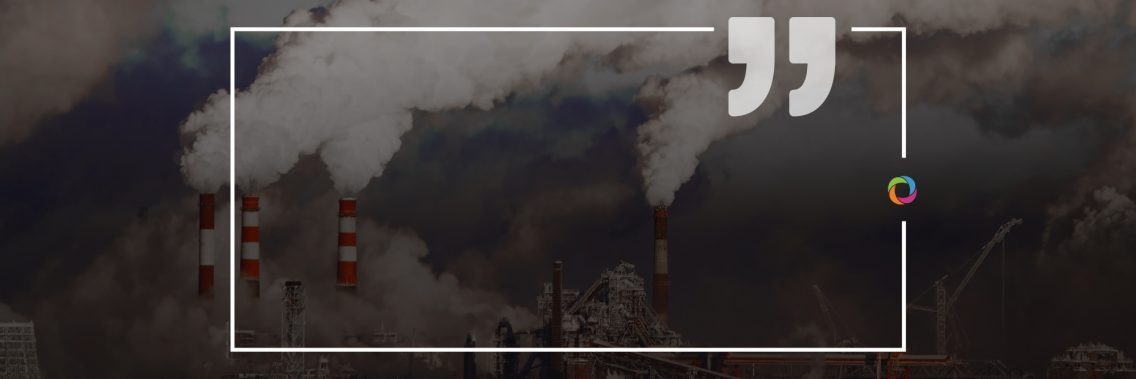According to the World Health Organisation, 9 out of 10 people worldwide breathe polluted air and it estimates that 4.2 million deaths every year can be attributed to outdoor air pollution. Air pollution is a priority on the global agenda and is widely recognised as a threat to both public health and economic progress and more countries are now taking action. Let’s check why we haven’t made real progress regarding fighting air pollution according to several environment experts.
Why is air pollution still on the increase after so much effort to reduce this?

“In spite of better air pollution quantification, tracking and management recently for the sustainable development goals, some developing regions in the world are still witnessing increasing air pollution levels, the reason being the lack of effective and efficient coordination between governmental agencies, pollution generators and the exposed population. Even though a government-backed centralized policy may be present, it proves to be ineffective at the ground level. A lack of public awareness is a hindrance to involving the general public as well as small-scale generators to curb their emissions and adopt more sustainable methods. Sometimes mistrust plays a significant role in this lack of coordination and cooperation. Also, air pollution is given third or fourth level importance after water management and solid waste management which leads to inadequate funds and policymaking. Also, higher standards, simple yet reliable ways of improved quantification, source identification and pollution movement/transport methods or solving approaches are a drawback as well.”

“Air pollution is the release of harmful substances into the atmosphere that have detrimental effects on humans and the environment. These harmful substances come mainly from natural and anthropogenic origins. Pollens from flowers, methane gas from animal digestions, and smoke from volcanic eruptions are examples of air pollution from natural sources. While exhaust from the combustion engines of automobiles and smoke from power plants are examples of air pollution from anthropogenic sources. Many efforts have been made globally to reduce air pollution; however, air pollution is increasing due to the lack of political willpower to reduce emissions by world leaders, especially those in developing nations. Climate change is another factor contributing to the increase in air pollution despite efforts to reduce it, because of the causative relationship between climate change and air pollution. Air pollution increases climate change as climate change increases air pollution. For instance, the release of methane and carbon dioxide raises the earth’s temperature while increased warming of the earth increases the formation of smog; a pollutant formed when combusted fossil fuel reacts with sunlight. Therefore, efforts to reduce air pollution will yield positive results when air pollution and climate change issues are addressed concurrently. Other factors contributing to the increase in air pollution are environmental racism, prejudiced loan practices, and the slow evolution to cleaner fuels and sustainable industrial processes.”

“A survey of 465 Asian cities by Clean Air Asia, an international NGO headquartered in the Philippines, revealed that 99% of these cities breath air that is much above the WHO prescribed limits. Many of these cities are developing and need large amounts of low-cost energy to accelerate growth. Dependency on coal as a source of energy and its increased burning for electricity is still a major cause of air pollution in most cities that are in the growing stages of development and urbanisation. With the expansion of cities and in the absence of integrated land use and mobility planning, the expansion of private car ownership is increasing vehicular exhaust and leading to a rise in the levels of fine particulate matter. This combination had led to high air pollution levels in the United States and Europe in the last century and, in more recent decades, has been lowering the quality of air in the global south especially in India and China. As an example, India’s coal consumption more than doubled between 2003 and 2013, and car ownership in the country increased by nearly 70% between 2013 and 2018. Hence rapid unplanned urbanisation and city development plans that do not integrate air quality management as a criterion for sustainable growth have been major reasons for increased air pollution especially from construction dust and re-suspended dust in roads, sometimes a result of vehicle movement and at other times construction. This has prevented the effective implementation of air pollution regulations since air pollution mitigation measures have not been an integral part of city development plans.”

“According to Environmental Pollution Centers (2021), air pollution is defined as the presence of toxic substances (natural and synthetic) in the air, at levels that constitute a health risk. The World Health Organization data shows that 9 out of 10 people breathe in air containing high levels of pollutants, with low- and middle-income countries suffering the highest exposure. WHO estimates that air pollution kills seven million people worldwide, every year. As the global population continues to increase, air pollution from human activities like mining, construction, transportation, industrial work, agriculture, cooking, and smelting will continue to increase, especially since half the world has no access to clean fuels or technologies. Increased industrial activities also emit several pollutants like nitrogen dioxide, sulphur dioxide, carbon monoxide, and particulate matter. Despite global efforts through policies and regulations to reduce the impact of domestic and industrial activities on air pollution, the results have not been widespread, especially in LMICs.”

“While air pollution is a recognized threat globally, it is still not regarded as a climate emergency in most countries. On one hand, the developed world contributes a bigger chunk of carbon monoxide and nitrogen oxides into the atmosphere mainly through the transportation and industrial sectors – the US alone has about 290 million registered cars and a similar number (292 million) is roaming the roads of China. On the other hand, most developing nations cannot afford to invest in technologies and sources that curtail emissions primarily through fossil fuels and vehicle exhaust emissions among others. And, because there is pressure to keep the economy growing, the low-income countries tend to sacrifice control of pollution for economic development. Achieving carbon neutrality is a prime balancing act: Tree plantation drives, waste recycling, erecting smog towers, green buildings, etc. are all only truly effective when simultaneous earnest efforts are made towards cutting emissions at source and finding alternatives to prevent pollutants from entering the atmosphere in the first place. Prevention rather than treating the illness!”

“The structure of the protocol does not cover and oblige all those who produce air pollution and responses to achieve the goals of the protocol are expected earlier than is realistic. The invested efforts for air pollution reduction are obviously insufficient, inadequate but also incorrectly directed. Air pollution is not mapped properly and in detail. The efforts are not controlled and not sufficiently propagated to target groups.”

Author, Researcher, Trainer, Knowledge developer and manager
“Pollution is the wanton addition and/or subtraction of more matter and/or energy in the ecosystem beyond its self-cleansing capacity. Air pollution causes a temporary to permanent impact on the physical, chemical, and biological purity of the atmosphere. Pollution may be (a) based on the physical state of the pollutant-i.e., solid, liquid, aerosol, and gaseous; or (b) based on the realm, i.e., the segment of the atmosphere most at risk, i.e., air, soil, water. Physical air pollutants may include hot flushes, dust, and smoke which comprises partially burnt organic products with aerodynamic diameter of 1 micron to 10 microns. The very fine particulate matter (PM) of a diameter less than 2.5 microns is often able to penetrate the body when inhaled, causing defective cardio-vascular and respiratory systems. In addition, chemical air pollution may result from manufacturing, agricultural spraying of pesticides, and open burning of garbage.”

“One of the key reasons for this in respect of sub-Saharan Africa is the use of coal for electricity generation and charcoal and timber for household use. The challenge for sub-Saharan Africa remains the need to increase the access of its growing population to electricity. Certainly, in the immediate future, fossil fuels such as coal but also cleaner fossil fuels such as natural gas will continue to be used as the main sources for the generation of electricity. In sub-Saharan Africa, there is a continued reliance by many communities on the use of biomass and charcoal for daily activities such as cooking and household heating particularly in the winter season. These activities result in increased ambient outdoor air pollution, especially particulate matter such as carbon black which has negative health consequences.”
What are the main consequences of air pollution?

“Health effects are the main human and animal-related consequences of increased air pollution levels. More studies need to be done to analyze the adverse effects on the biosphere and atmosphere. Certain respiratory, heart, and lung disorders can develop from short-term and/or long-term exposure to levels over the permissible limits. PM10 and PM2.5 can pose a grave danger to the respiratory tracts. CO and unburnt carbon from exhaust fumes are also grave health hazards. Air pollution also interacts with the atmosphere and cause climatic changes and unexpected weather patterns/events. Ambient air quality monitoring of increased pollution levels and unexpected weather patterns which disrupt normal urban life have shown a positive correlation which is becoming more and more obvious.”

“Nothing good comes out of air pollution. Generally, the consequences of air pollution range from an obstinate cough to shortened life expectancy and even death for humans. Other consequences of air pollution are the destruction of the earth’s atmosphere, forests, oceans, rivers, and wildlife. For instance, the release of chlorofluorocarbons in the atmosphere causes the depletion of the ozone layer and further aggravates global warming. Climate change induced hazards such as floods from sea level rise and drought due to warmer temperatures are other consequences of air pollution. In addition, the production of acid rain from the reaction of sulfur dioxide and nitrogen dioxide with water, oxygen, and other atmospheric chemicals that fall into water bodies can lead to eutrophication and further destruction of the ecological system. More specifically, other consequences of air pollutants such as smog are irritation of the eyes and throat and impairment to the lungs. Soot can penetrate the lungs and bloodstream leading to heart attacks and exacerbate bronchitis and hasten death. Hazardous air pollutants such as mercury can destroy the central nervous system. When exposed to a large concentration, children’s brains and kidneys can be damaged by lead while negligible exposure has been reported to affect IQ and the ability to learn in children. Lung and eye irritation, cancer, and blood and liver diseases have been linked to air pollutants such as polycyclic aromatic hydrocarbons (PAHs), dioxins, and benzene. Air pollution also has economic consequences, for instance, the Organization for Economic Cooperation and Development has projected that the cost of healthcare for air pollution-related ailments was US$21 billion in 2015 but may reach US$176 billion in 2060”.

“Air pollution is a major environmental threat to public health globally and accounts for an estimated 7 million premature deaths every year. Nine out of ten people worldwide breathe air containing levels of pollutants that exceed World Health Organization limits. Around four million people died in 2019 from exposure to fine particulate outdoor air pollution, with the highest death rates occurring in Asia and Eastern Europe. Exposure to high levels of air pollution may lead to a variety of adverse health outcomes. This includes an increased risk of respiratory infections, heart disease, and lung cancer. Children, the aged, and the economically underprivileged are more susceptible to air pollution. Air pollution can cause cardiovascular problems, allergies, asthma attacks, conjunctivitis, bronchial diseases, lung or skin cancers, vision problems, blood problems and has been recently linked to poor cognitive development in children and reduced memory in the elderly. Along with harming human health, air pollution can cause a variety of environmental effects, for instance, the burning of fossil fuels further results in the release of nitrogen and sulphur oxides into the atmosphere, consequently leading to the formation of acid rain which has a negative impact on soil and plants. Air pollution also has a major impact on agriculture with several proven studies on the impact of ozone on plant growth. Additionally, air pollution has a large impact on the economic state of a country. The projected increase in concentrations of PM2.5 and ozone will in turn lead to substantial effects on the economy. According to the calculations in an OECD report, global air pollution-related healthcare costs are projected to increase from US$21 billion in 2015 to US$176 billion in 2060.”

“Air pollution has serious effects on human health. Depending on the degree of exposure and the type of pollutant, these effects can vary from simple symptoms like coughing, red eyes, irritation of the respiratory tract to acute conditions like asthma and chronic lung diseases, obstructive pulmonary disease, stroke, and heart disease, and bronchitis with economic implications on the population. A number of pollutants gases are linked to the “greenhouse effect”, contributing to global warming and climate change.”

“Air pollution is carcinogenic to humans. It reduces life expectancy. It is widely being recognized as a silent killer with short and long-term consequences, the foremost being on human health. In the short term, it can lead to mild symptoms or discomfort, like heat fatigue, cramps, eye irritation, coughing, elevated anxiety, etc. but, as the consequences on health deteriorate, it can cause chronic or acute respiratory diseases including asthma, chronic bronchitis, lung cancer, cardiovascular illness, and even death! According to WHO (2016), ambient air pollution accounts for 4.5 million premature deaths worldwide per year, 91% of whom live in low- and middle-income countries where an estimated 40,000 children die before their 5th birthday because of exposure to PM2.5. Air pollution leads to a reduced ability to work and lower participation rates in the labor force, children miss school days, it elevates mental disorders, employees struggle with concentration spans and, as per UNEP, air pollution can have huge negative effects on overall cognitive intelligence increasing the risk of Alzheimer’s. Alzheimer’s disease in the US alone cost US$226 billion in health services in 2015 – count in other air pollution-related diseases burdening the global economy, it is a huge negative externality. According to research by CERN and endorsed by WEF, it is estimated that air pollution has an economic cost of US$2.9 trillion or 3.3% of global GDP. The financial cost from fossil fuel air pollution is estimated to be US$900 billion (China), US$600 billion (US), and US$150 billion (India) per year. Globally, the annual economic loss attributed to PM2.5 pollutants is US$101 billion because of roughly 2 billion days of work absence due to asthma-related sick leave.”

“I think that the main consequences are incomprehensible, that they have just begun and we will not be able to control them. Air pollution knows no boundaries in the homosphere, in stratification only to some extent but damage is also present there due to the consequences of the winds mixing between the hemispheres. The world’s population must be informed that man, in contrast to some animals and plants, has no hyper storage for the storing of pollutants so the pollutant or its derivative will end up in the man’s secondary metabolism with certain consequences for health. I think that is the main consequence and the world population should be considering that we are just at the beginning of the immunity change period and that deterioration is expected to redefine the views of the pollution from the roots.”

“Gaseous air pollution may lead to acid rain causing the indiscriminate and wanton drying of vegetation. This disrupts biological resource, habitats, wildlife and tourism. Hazardous radiation such as ultraviolet rays may be released to the air. Air pollution from garbage burning releases toxic carcinogenic furan and dioxin fumes plus other unintended persisted organic pollutants (UPoPs). Whereas there are many mechanisms to combat air pollution through the adoption of various protocols such as the Montreal protocol, a poor economic base, lack of political will, lack of appropriate technology, open greed and other related factors have hampered progress. Thus air pollution can cause permanent long term havoc in aquatic, soil and air systems, thereby disrupting existing therapeutic, recreational and livelihood prowess.”

“The main consequences of air pollution are its contribution towards climate change and the detrimental effect on the health of people globally. It is well known that pollutants and greenhouse gases such as CO2, methane, SO2, and NO2, released through various activities in industrial, manufacturing, electricity, and agricultural sectors, make a significant contribution to this. The long-term health effects from exposure to ambient air pollution of concern especially considering the WHO estimate of 4.2 million deaths being attributed to outdoor air pollution annually. Another important aspect is the negative effect of air pollution, mainly deposits of nitrogen and sulphur, on the environment and ecosystems across the globe where it may affect water or soil quality and may reduce biodiversity.”
What should the international community do to counteract air pollution?

“General public and business awareness needs to be increased quite significantly to counteract air pollution. Air pollution management needs to be given equal importance as water management and solid waste management at the local and ground level. The polluted air is just as persistent as contaminated water or regular waste. It doesn’t vanish but lingers on and sometimes comes back with a vengeance. More allocation of funds and serious government backing are the needs of the hour. International agencies and communities should step up the pressure on countries that are not doing enough to address this growing menace. Regulatory bodies (international, national, and local) need to become more transparent, accountable, and strict. Punish the offenders and reward the hard workers through better governance. Responsibility and ownership are the key traits to be had in order to make the right decisions and ensure total cooperation from all stakeholders. No segregation of regions or populations should be done, rather a collective approach needs to be followed in order to reduce the increasing levels of air pollution. Also, it should not be made into a rich vs. poor issue. After all, it’s One planet for All.”

“The international community should pay more attention to the scientific community on air pollution and climate change issues. More attention should be on hastening the transition to cleaner fuels and sustainable industrial processes and the total eradication of environmental racism and prejudiced loan practices. Furthermore, to counteract air pollution, the international community must put more effort into regulating energy combustion, implementing air quality, automobile emissions and fuel quality standards, as well as employing emission taxes for defaulting nations”.

Acknowledging that air pollution affects several aspects of society and that addressing air pollution results in multiple benefits to human health, the economy, ecosystems, and the climate is the first step in addressing air pollution. For this, international dialogue needs to prioritise air pollution in global dialogues and include it on the agenda of global conventions. In the absence of a stand-alone sustainable development goal for air pollution, global debates on achieving SDGs need to mainstream air pollution on the agenda of action for achieving the SDGs. The climate and clean air dialogue are still restricted to the air pollution community. There is a need to talk about the co-benefit approach to address air pollution and climate pollutants to align mitigation measures for both and to create coherence between climate and clean air strategies. Regional cooperation on science, technology, policy, measures, and best practices related to addressing air pollution and strengthening capacities to develop national and subnational emissions inventories for prioritizing mitigation action in sectors is the need of the hour. There is also the need to integrate and strengthen air pollution management aspects on the national development agenda and to internalize pollution costs. Finally, all this cannot be achieved without public engagement. The international community needs to create a process of best practice sharing and partnerships that will drive the process of creating awareness at the local, subnational, and national levels and within the private sector of the negative environmental, health, and socioeconomic impacts of pollution, as well as the economic benefits of taking action. In the absence of a one-size-fits-all recipe for reducing air pollution, policies need to be tailored to specific local circumstances. But the international community can drive the process of knowledge sharing of good practices and successful experiences to help cities to prepare adapted versions of the strategies for air quality management.

“At the global level, a combination of policy enactment and implementation, focusing on pollution controls, energy and climate, agricultural production systems, and addressing human consumption habits could drastically improve air quality throughout globally. At the country level, strategies like population control, investment in clean energy, adequate town planning, and education and awareness-raising on pollution will significantly counteract air pollution.”

“The responsibility for taking measures to counteract our decades of misuse of the planet lies with global policy-makers, implementers, EPAs, companies, industries, down to each individual in their own capacity. Laws and policies on paper to combat pollution and the adverse impacts of climate change exist the world over, but the transgression rests in the fissures between formulation and execution. The foundations of model development lie on adopting a low carbon economy and sustainability. The international community must declare a global climate emergency; establish a worldwide coalition of countries to demand climate justice, holding developed countries accountable and financially liable to abetting the crisis of pollution, safeguarding the rights of vulnerable countries. There is an urgent actionable need to reward and incentivize carbon-neutral economic activity, a transition from fossil fuels to renewables, improve rapid urban public transport, phase out diesel and petrol cars to introduce EVs and formulate emissions standards for motor vehicles, legislate the minimization of the use of plastics, introduce clean technologies that reduce industrial smokestack emissions, appropriate waste disposal and methane capture, the recycle-reuse-reduce concept, avoid unsustainable farming practices, among many others. While as individuals, since we all share the same planet and breathe the same air, it is crucial to review our own personal choices of daily living by adopting responsible habits like reducing the number of trips we take in our car, prioritize walking/cycling, carpool, minimize the use of plastic, buy less, reduce waste, plant trees, recycle and reuse.”

“The international community should understand that everyone must be involved in the fight against air pollution! How should a mass phenomenon be massively opposed? By education! Mass education! In order to achieve mass education, it should be directed to as wide an audience as possible: the youngest population in kindergartens and other pre-school institutions for a long period of time. It takes at least 25 years of education to achieve collective consciousness. Social media can speed up this process, but can also take it into the wrong direction and I believe this is the case now because the right messages are not passed on to the target groups in regular periods. The properly formed awareness of the individual and the group is analogous to the cultivation of not annual but perennial plants/plantations. Humanity should be fed with essential, serious information from the earliest age because the child is the father of the man.”

“Care should be taken to ensure that countries, counties, and states have the requisite means and ways of controlling air pollution from industrial, domestic, and industrial waste. The global community should collaborate to combat open burning of wastes, aerial spraying, ozone layer depletion and the control of industrial pollution through focused economic, regulatory, persuasive and legislative measures.”

“Sub-Saharan Africa needs a new energy ecosystem that provides energy alternatives to unsustainable biomass and coal use at competitive economic prices. Continued innovation and collaborative research in the development of mitigation and abatement technologies for use in the energy, manufacturing, and agricultural sectors will go a long way to improving the situation and positively contribute towards ensuring a future with less air pollution. Although investment and funding are needed to move towards using more renewable sources of energy such as wind and solar which will have a positive impact on reducing air pollution, it is to be noted that sub-Saharan Africa, more importantly, needs a systems innovation approach as part of its energy ecosystem transition from its current use to a green energy future.”
Check out more than 500 job opportunities in the Environment sector here.

